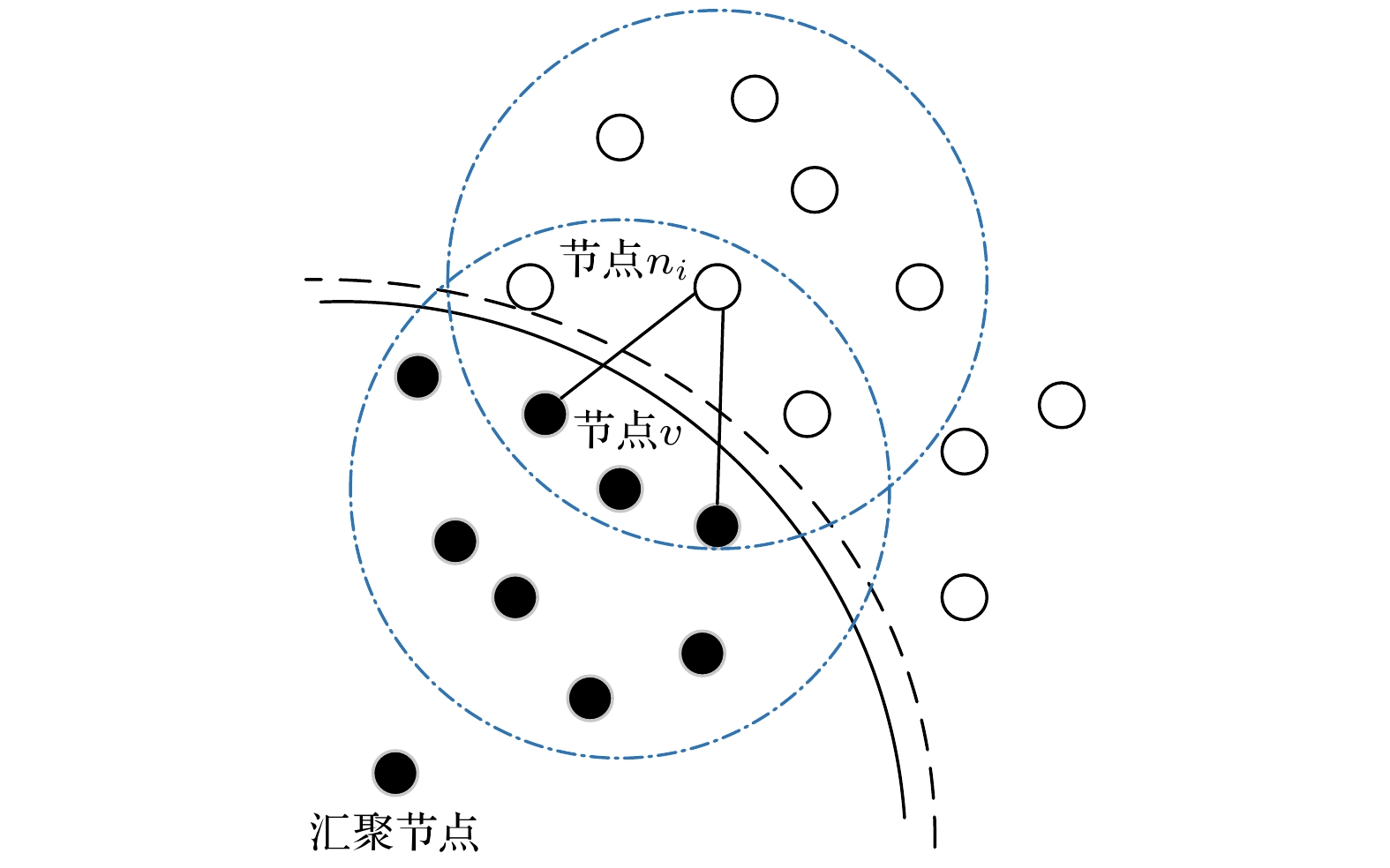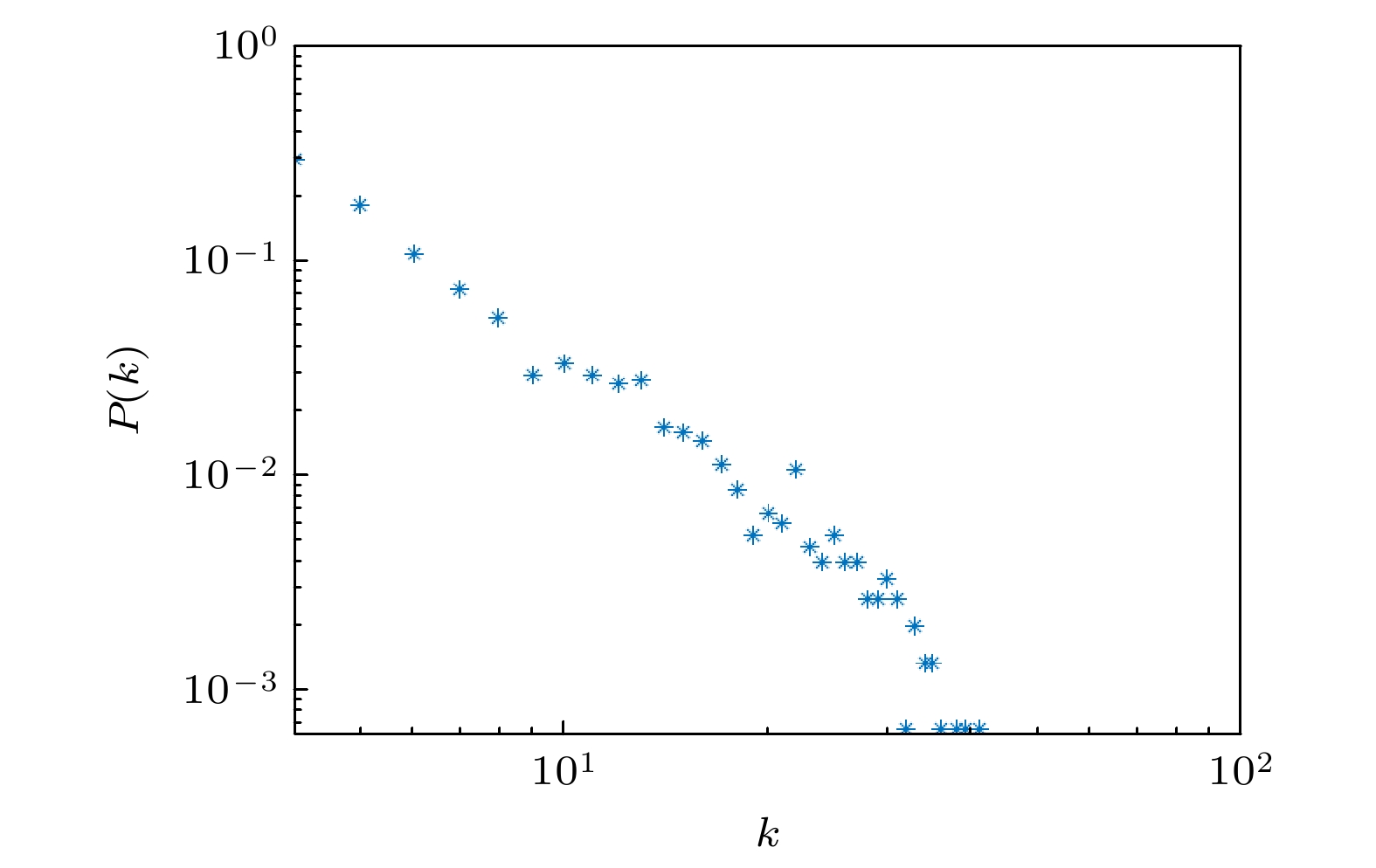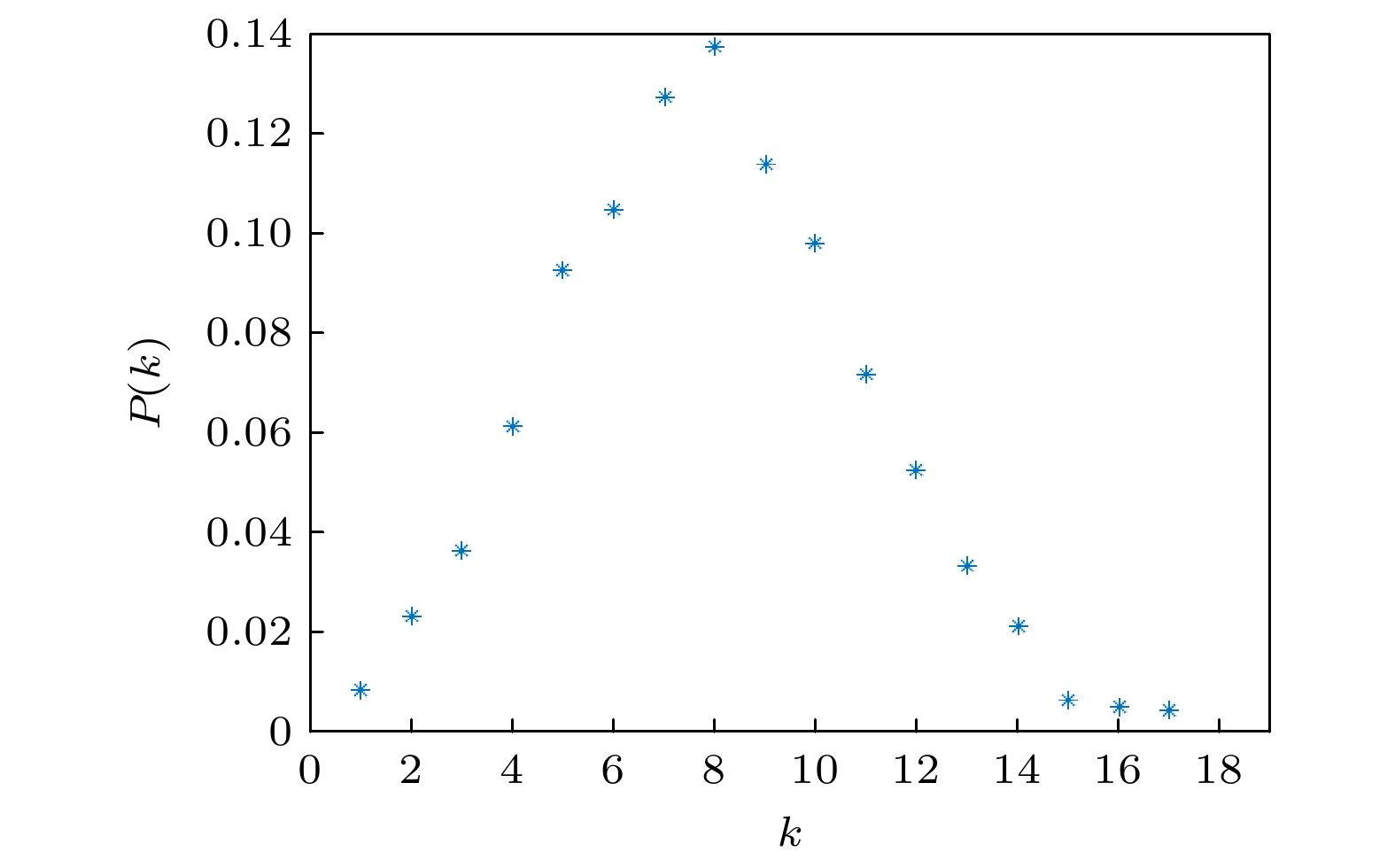-
In many complex networks, such as communication networks, power grids, and transportation networks, the main task is load transmission from sources to destinations. Therefore, the transmission throughput is a very important indicator to measure the network performance, and improving the throughput becomes one of the hotspots in the research of these complex networks. Many researchers have proposed different routing algorithms to improve the network throughput. However, few of them considered the spatial location of nodes in the network. Indeed, many real-world networks can be modeled by spatial networks, where the spatial location of nodes plays a vital role in determining the structure and dynamic behaviors of such networks. Specifically, when the locations of nodes are considered, each link has a length. And the shortest path may have different meaning. Traditionally, the shortest path indicates the path which passes the least number of links from source to destination, or the least number of hops. However, when the length of link is taken into account, the least number of links does not mean the least summation of link lengths along the path. The latter can be called the shortest path length. To this end, we proposes an efficient routing strategy for spatial networks based on the shortest path length in this work. In order to test the effectiveness of the algorithm, the network throughput
${R}_{\rm c}$ is used, at which the network changes from a free flow state to a congestion state, to measure the performance of the network. Simulations of homogeneous and heterogeneous spatial networks show that compared with the traditional least number of hops routing strategy, the routing algorithm based on the shortest path length proposed in this paper can effectively improve the throughput of the network. The routing algorithm proposed in this paper can be applied to many real-world spatial networks for improving their performances.-
Keywords:
- routing strategy /
- spatial network /
- congestion
[1] Erdös P, Rényi A 1959 Publ. Math. 6 290
[2] Barabási A L, Albert R 1999 Science 286 509
 Google Scholar
Google Scholar
[3] Watts D J, Strogatz S H 1998 Nature 393 440
 Google Scholar
Google Scholar
[4] 陈关荣 2008 力学进展 38 653
 Google Scholar
Google Scholar
Chen G R 2008 Adv. Mech. 38 653
 Google Scholar
Google Scholar
[5] 马金龙, 张俊峰, 张冬雯, 张红斌 2021 物理学报 70 078902
 Google Scholar
Google Scholar
Ma J L, Zhang J F, Zhang D W, Zhang H B 2021 Acta Phys. Sin. 70 078902
 Google Scholar
Google Scholar
[6] 于晓 2020 软件工程 23 1
 Google Scholar
Google Scholar
Yu X 2020 Software Engineering 23 1
 Google Scholar
Google Scholar
[7] 任卓明 2020 物理学报 69 048901
 Google Scholar
Google Scholar
Ren Z M 2020 Acta Phys. Sin. 69 048901
 Google Scholar
Google Scholar
[8] Hearnshaw E J S, Wilson M M J 2013 Int. J. Operat. Product. Manage. 33 442
 Google Scholar
Google Scholar
[9] Chen S Y, Huang W, Cattani C, Altieri G 2012 Math. Probl. Eng. 2012 732698
 Google Scholar
Google Scholar
[10] Tan F, Wu J J, Xia Y X, Tse C K 2014 Phys. Rev. E 89 062813
 Google Scholar
Google Scholar
[11] 陈华良, 刘忠信, 陈增强, 袁著祉 2009 物理学报 58 6068
 Google Scholar
Google Scholar
Chen H L, Liu Z X, Chen Z Q, Yuan Z Z 2009 Acta Phys. Sin. 58 6068
 Google Scholar
Google Scholar
[12] 刘伟彦, 刘斌 2014 物理学报 63 248901
 Google Scholar
Google Scholar
Liu W Y, Liu B 2014 Acta Phys. Sin. 63 248901
 Google Scholar
Google Scholar
[13] 赵磊, 周金和 2019 计算机科学 46 137
 Google Scholar
Google Scholar
Zhao L, Zhou J H 2019 Computer Science 46 137
 Google Scholar
Google Scholar
[14] 刘金良 2013 物理学报 62 040503
 Google Scholar
Google Scholar
Liu J L 2013 Acta Phys. Sin. 62 040503
 Google Scholar
Google Scholar
[15] 赵宇红 2019 博士学位论文 (北京: 北京科技大学)
Zhao Y H 2019 Ph. D. Dissertation (Beijing: University of Science and Technology Beijing) (in Chinese)
[16] 李世宝, 娄琳琳, 陈瑞祥, 洪利 2014 物理学报 63 028901
 Google Scholar
Google Scholar
Li S B, Lou L L, Chen R X, Hong L 2014 Acta Phys. Sin. 63 028901
 Google Scholar
Google Scholar
[17] 邵斐, 蒋国平 2011 物理学报 60 078902
 Google Scholar
Google Scholar
Shao F, Jiang G P 2011 Acta Phys. Sin. 60 078902
 Google Scholar
Google Scholar
[18] Yan G, Zhou T, Hu B, Fu Z Q, Wang B H 2005 Phys. Rev. E 73 046108
 Google Scholar
Google Scholar
[19] Huang W, Chow T W S 2009 Chaos 19 043124
 Google Scholar
Google Scholar
[20] Wang W X, Wang B H, Yin C Y, Xie Y B, Zhou T 2006 Phys. Rev. E 73 026111
 Google Scholar
Google Scholar
[21] Xia Y X, Wang C, Shen H L, Song H N 2020 Physica A 559 125071
 Google Scholar
Google Scholar
[22] Zhang M, Chen S, Sun L, Du W, Cao X 2021 Engineering 7 465
 Google Scholar
Google Scholar
[23] Du W B, Zhou X L, Jusup M, Wang Z 2016 Sci. Rep. 6 19059
 Google Scholar
Google Scholar
[24] Jiang L, Xu Q, Pan H, Dai Y, Tong J 2020 Secur. Commun. Netw. 2020 6513920
 Google Scholar
Google Scholar
[25] Bai G H, Li Y J, Fang Y N, Zhang Y A, Tao J Y 2020 Reliab. Eng. Syst. Saf. 193 106602
 Google Scholar
Google Scholar
[26] Zhao L, Lai Y C, Park K, Ye N 2005 Phys. Rev. E 71 026125
 Google Scholar
Google Scholar
[27] Dall J, Christensen M 2002 Phys. Rev. E 66 016121
 Google Scholar
Google Scholar
[28] Jiang L R, Jin X Y, Xia Y X, Ouyang B, Wu D P, Chen X 2015 Int. J. Distrib. Sens. Netw. 2014 764698
 Google Scholar
Google Scholar
-
图 6 平均度
$ \left\langle{k}\right\rangle=4 $ 时, 不同节点规模下两种路由方式平均路径长度的比较 (a) LAEE演化模型; (b)改进的随机几何图模型. 图中每个点是10次仿真的平均值Figure 6. With the average degree
$ \left\langle{k}\right\rangle=4 $ , the average path length under two routing strategies with different node sizes: (a) LAEE evolution model; (b) improved random geometric graph model. Each point is the average of 10 runs.图 7 平均度
$ \left\langle{k}\right\rangle=4 $ 时, 不同节点规模下两种路由方式平均跳数的比较 (a) LAEE演化模型; (b)改进的随机几何图模型. 图中每个点是10次仿真的平均值Figure 7. With the average degree
$ \left\langle{k}\right\rangle=4 $ , the average number of hops under two routing strategies with different node sizes: (a) LAEE evolution model; (b) improved random geometric graph model. Each point is the average of 10 runs.图 8 平均度
$ \left\langle{k}\right\rangle=4 $ 时, 不同节点规模下两种路由方式的网络最大吞吐量$ {R}_{\rm{c}} $ 的比较 (a) LAEE演化模型; (b)改进的随机几何图模型. 图中每个点是10次仿真的平均值Figure 8. With the average degree
$\left\langle{k}\right\rangle=4$ ,$ {R}_{\rm{c}} $ under two routing strategies with different node sizes: (a) LAEE evolution model; (b) improved random geometric graph model. Each point is the average of 10 runs.图 9 节点数
$ N=1000 $ 时, 不同平均度下两种路由方式平均路径长度的比较 (a) LAEE演化模型; (b)改进的随机几何图模型. 图中每个点是10次仿真的平均值Figure 9. With N = 1000, the average path length under two routing strategies with different average degrees: (a) LAEE evolution model; (b) improved random geometric graph model. Each point is the average of 10 runs.
图 10 节点数
$ N=1000 $ 时, 不同平均度下两种路由方式平均跳数的比较 (a) LAEE演化模型; (b)改进的随机几何图模型. 图中每个点是10次仿真的平均值Figure 10. With N = 1000, the average number of hops under two routing strategies with different average degrees: (a) LAEE evolution model; (b) improved random geometric graph model. Each point is the average of 10 runs.
图 11 节点数
$ N=1000 $ 时, 不同平均度下两种路由方式的网络最大吞吐量$ {R}_{\rm{c}} $ 的比较 (a) LAEE演化模型; (b)改进的随机几何图模型. 图中每个点是10次仿真的平均值Figure 11. With
$ N=1000 $ ,$ {R}_{c} $ under two routing strategies with different average degrees: (a) LAEE evolution model; (b) improved random geometric graph model. Each point is the average of 10 runs.图 13 改进的随机几何图模型中, 节点数N = 1000,
$ \left\langle{k}\right\rangle $ = 4时的介数分布 (a)最少跳数路由; (b)最短路径长度路由Figure 13. Betweenness distribution of the improved random geometric graph with N = 1000,
$ \left\langle{k}\right\rangle $ = 4: (a) Least number of hops routing strategy; (b) shortest path length routing strategy. -
[1] Erdös P, Rényi A 1959 Publ. Math. 6 290
[2] Barabási A L, Albert R 1999 Science 286 509
 Google Scholar
Google Scholar
[3] Watts D J, Strogatz S H 1998 Nature 393 440
 Google Scholar
Google Scholar
[4] 陈关荣 2008 力学进展 38 653
 Google Scholar
Google Scholar
Chen G R 2008 Adv. Mech. 38 653
 Google Scholar
Google Scholar
[5] 马金龙, 张俊峰, 张冬雯, 张红斌 2021 物理学报 70 078902
 Google Scholar
Google Scholar
Ma J L, Zhang J F, Zhang D W, Zhang H B 2021 Acta Phys. Sin. 70 078902
 Google Scholar
Google Scholar
[6] 于晓 2020 软件工程 23 1
 Google Scholar
Google Scholar
Yu X 2020 Software Engineering 23 1
 Google Scholar
Google Scholar
[7] 任卓明 2020 物理学报 69 048901
 Google Scholar
Google Scholar
Ren Z M 2020 Acta Phys. Sin. 69 048901
 Google Scholar
Google Scholar
[8] Hearnshaw E J S, Wilson M M J 2013 Int. J. Operat. Product. Manage. 33 442
 Google Scholar
Google Scholar
[9] Chen S Y, Huang W, Cattani C, Altieri G 2012 Math. Probl. Eng. 2012 732698
 Google Scholar
Google Scholar
[10] Tan F, Wu J J, Xia Y X, Tse C K 2014 Phys. Rev. E 89 062813
 Google Scholar
Google Scholar
[11] 陈华良, 刘忠信, 陈增强, 袁著祉 2009 物理学报 58 6068
 Google Scholar
Google Scholar
Chen H L, Liu Z X, Chen Z Q, Yuan Z Z 2009 Acta Phys. Sin. 58 6068
 Google Scholar
Google Scholar
[12] 刘伟彦, 刘斌 2014 物理学报 63 248901
 Google Scholar
Google Scholar
Liu W Y, Liu B 2014 Acta Phys. Sin. 63 248901
 Google Scholar
Google Scholar
[13] 赵磊, 周金和 2019 计算机科学 46 137
 Google Scholar
Google Scholar
Zhao L, Zhou J H 2019 Computer Science 46 137
 Google Scholar
Google Scholar
[14] 刘金良 2013 物理学报 62 040503
 Google Scholar
Google Scholar
Liu J L 2013 Acta Phys. Sin. 62 040503
 Google Scholar
Google Scholar
[15] 赵宇红 2019 博士学位论文 (北京: 北京科技大学)
Zhao Y H 2019 Ph. D. Dissertation (Beijing: University of Science and Technology Beijing) (in Chinese)
[16] 李世宝, 娄琳琳, 陈瑞祥, 洪利 2014 物理学报 63 028901
 Google Scholar
Google Scholar
Li S B, Lou L L, Chen R X, Hong L 2014 Acta Phys. Sin. 63 028901
 Google Scholar
Google Scholar
[17] 邵斐, 蒋国平 2011 物理学报 60 078902
 Google Scholar
Google Scholar
Shao F, Jiang G P 2011 Acta Phys. Sin. 60 078902
 Google Scholar
Google Scholar
[18] Yan G, Zhou T, Hu B, Fu Z Q, Wang B H 2005 Phys. Rev. E 73 046108
 Google Scholar
Google Scholar
[19] Huang W, Chow T W S 2009 Chaos 19 043124
 Google Scholar
Google Scholar
[20] Wang W X, Wang B H, Yin C Y, Xie Y B, Zhou T 2006 Phys. Rev. E 73 026111
 Google Scholar
Google Scholar
[21] Xia Y X, Wang C, Shen H L, Song H N 2020 Physica A 559 125071
 Google Scholar
Google Scholar
[22] Zhang M, Chen S, Sun L, Du W, Cao X 2021 Engineering 7 465
 Google Scholar
Google Scholar
[23] Du W B, Zhou X L, Jusup M, Wang Z 2016 Sci. Rep. 6 19059
 Google Scholar
Google Scholar
[24] Jiang L, Xu Q, Pan H, Dai Y, Tong J 2020 Secur. Commun. Netw. 2020 6513920
 Google Scholar
Google Scholar
[25] Bai G H, Li Y J, Fang Y N, Zhang Y A, Tao J Y 2020 Reliab. Eng. Syst. Saf. 193 106602
 Google Scholar
Google Scholar
[26] Zhao L, Lai Y C, Park K, Ye N 2005 Phys. Rev. E 71 026125
 Google Scholar
Google Scholar
[27] Dall J, Christensen M 2002 Phys. Rev. E 66 016121
 Google Scholar
Google Scholar
[28] Jiang L R, Jin X Y, Xia Y X, Ouyang B, Wu D P, Chen X 2015 Int. J. Distrib. Sens. Netw. 2014 764698
 Google Scholar
Google Scholar
Catalog
Metrics
- Abstract views: 7950
- PDF Downloads: 125
- Cited By: 0
















 DownLoad:
DownLoad:


































